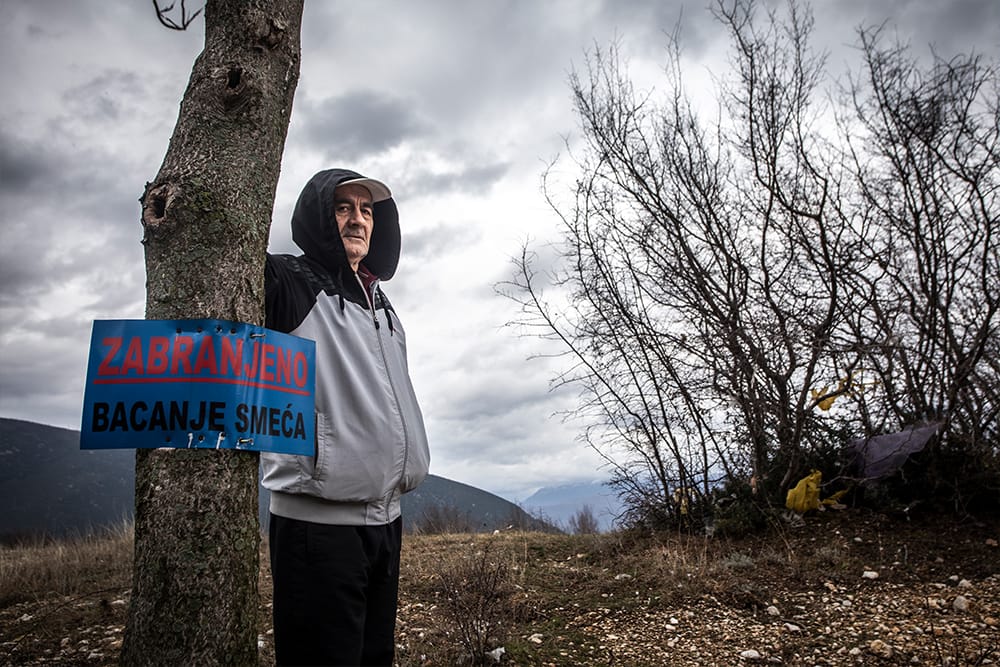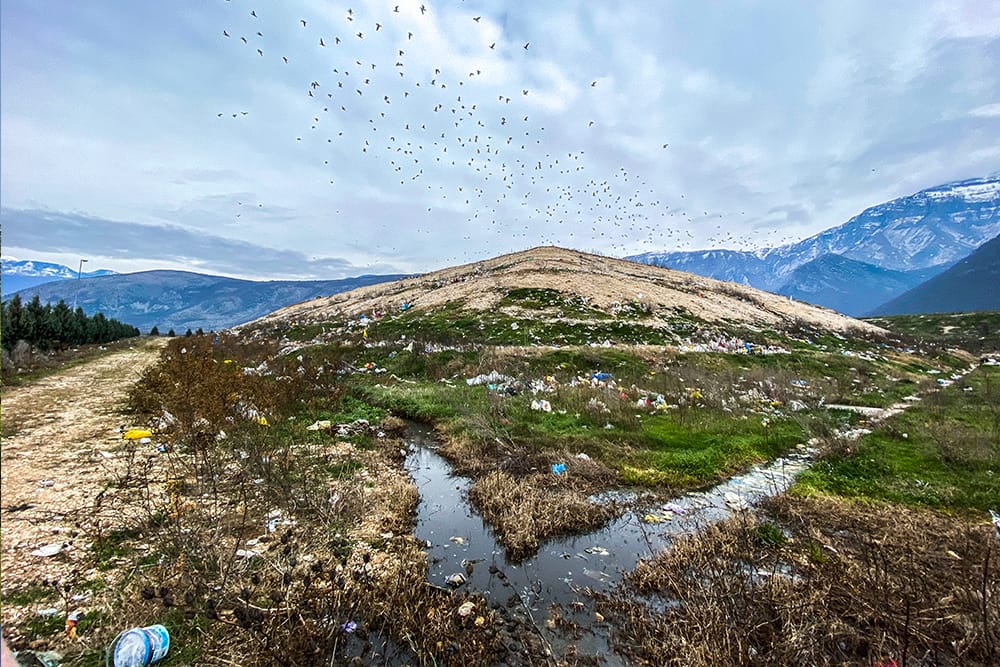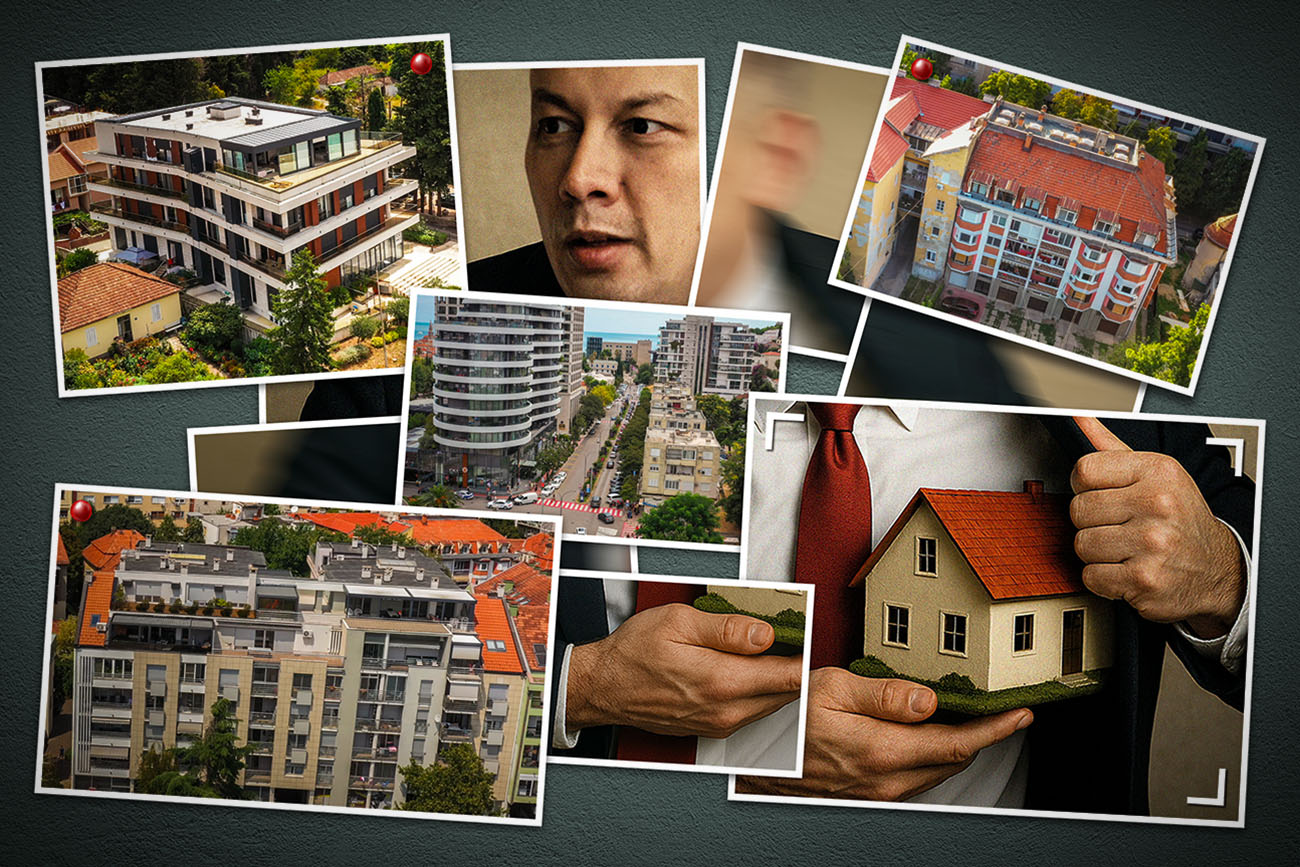Every day, Mostar utility trucks bring more than 100 tons of waste to the city landfill, which has been operating for years without an environmental and water permit. Wastewater occasionally runs out from the landfill and flows into the nearby Sušica stream, which passes through the Vrapčići settlement.
Since 2008, more than 16 million BAM has been invested in arranging the landfill but the wastewater treatment plant was never established because “it never got around to it”. All these years, the public company “Deponija” has never analyzed the water of the Sušica stream, claiming that it has no obligation to do so.
Instead, this was done by the Water Institute of Bijeljina for the CIN investigation. The institute analyzed the water from the Sušica riverbed, and the wastewater lagoon, i.e. the basin receiving the wastewater from the landfill. The results showed that the concentration of harmful substances is far higher than the values allowed by the FBiH Regulation on the conditions of wastewater discharge into the environment and public sewerage systems.
Don't want to miss our stories?
Sign up for our newsletter.
Don't want to miss our stories?
Sign up for our newsletter.
Due to health concerns, the locals blocked access to the landfill several times and filed a criminal complaint against the management of the Public Enterprise “Deponija” and the City of Mostar before the Mostar Cantonal Prosecutor’s Office.
“We have been exposed to all sorts of pressure. By the police, by politicians, absolutely all sorts of pressure, from the threat of dismissal”, says Omer Hujdur, a member of the Association “Jer nas se tiče”.
Permits down the drain
The stench of landfills and hundreds of plastic bags caught on the branches of dried trees are the sad and the safest signposts to Mostar’s regional landfill. Near the entrance to the landfill, black water has been leaking uncontrollably from the old landfill for years.
“It is ten years since this has been leaking from the old landfill, which was closed a long time ago. Nobody cares about this and it’s a disaster”, says resident Nijaz Hodžić.

Analysis of the wastewater sample taken from the wastewater lagoon and landfill pipes showed 100 times higher values of arsenic than allowed. Experts say that arsenic is the king of poisons, as it accumulates in the bones and damages the brain and liver.
The high values of chemical oxygen demand (COD) and biological oxygen demand (BOD), suggest the contamination with other substances as well. These two parameters show the total wastewater pollution. According to the regulation, the COD levels should not exceed 700 g/m³, and the sample taken from the lagoon contained 15,400 g/m³.
Chemical engineer Amel Salihagić explains that the findings point to the contaminants that could cause severe consequences for human health, such as fetal malformations in pregnant women, cancer, and other serious diseases.
The Mostar landfill was previously managed by the company “Uborak”, which went bankrupt. With the formation of the new PE “Landfill”, the idea was to start with modern waste management, which is why the garbage delivery to the old part of the landfill was suspended. Although the old part of the landfill had been receiving hazardous waste for more than 60 years, it has never been fully rehabilitated because the City of Mostar does not have the three million BAM to close it and control the leachate.
As a result, the new part of the landfill, which is located in the vicinity of the old landfill, faced problems even before it is opened due to poisoned leachate from the old part irrigating the soil uncontrollably and going into Sušica. The PE “Deponija” has no obligation to control wastewater in this stream because it does not have a water permit. The water permit is a document issued by the Adriatic Sea Watershed Agency, which prescribes, among other things, the manner and frequency of controls.
CIN reporters briefed Chief FBiH Zoning Inspector Ejub Salkić on the results of the landfill leachate analysis. He claims to be aware of all the problems, but, according to him, that the landfill so far functions well.
“We have a problem. To close this landfill we need an environmental permit for closure or we need an environmental permit for further disposal. We have no alternative”, says inspector Salkić. So far, the FBiH Inspection Affairs Administration has issued a total of 7 violation charges against PE “Deponija” and its director, as well as against the leader of Mostar. The total amount of fines was around 11 thousand BAM.
Former mayor of Mostar, Ljubo Bešlić, was fined BAM 1,000 for failing to comply with the permit to close the landfill. Inspector Salkić explains that the process should have been completed and thus prevented the leak of water from the old landfill.
According to the FBiH Ministry of Environment and Tourism, the problems at the landfill are the responsibility of the City Administration and the management of the PE “Deponija”, as they so far failed to find an adequate solution for the rehabilitation of the infrastructure.
“There could be a lot more waste selection. It is one way to improve your financial status. By selling raw materials of all sorts”, says Assistant FBiH Minister Stjepan Matić.

Unknown future of the landfill
Between the old and the new landfills is a wastewater lagoon, the untreated water of which is pumped back to the landfill.
While director of the PE “Deponija” is on sick leave, Azra Repeša from PE “Deponija”, explains the drainage system they use. Namely, all the liquid goes to the lagoon, from where it then circulates to the body of the landfill and so on, in a circle. The landfill does not have a treatment facility to purify the contaminated water before discharging it into the environment.
The PE “Deponija” missed the opportunity of getting BAM 3 million from the World Bank for a water treatment plant. Although a five-year construction permit was issued in 2012, the plant was never built because the management was not satisfied with the bidders. The process was then delayed until the project finally expired and the World Bank has withdrawn its assistance.
“God willing, we’ll do it if we [management, author’s note] stay, if not someone else will deal with it”, says Repeša.
Over the past eight years, the FBiH Inspectorate supervised the work of PE “Deponija” and ordered its management to monitor the quality of water, soil, air, and noise. Inspectors fined the enterprise and its director Abdurahman Bećirović at least 10 thousand BAM for ignoring the obligations arising from the environmental permit.
The PE “Deponija” never applied for a water permit because to get the permit they would need to have a treatment plant, and the Ministry did not extend their environmental permit because they did not have an Environmental Impact Assessment Study.
The Ministry formed a team which, in late April 2021, made a decision to close the existing and form new sections of the landfill in the next three years. In the meantime, PE “Deponija” and the City of Mostar satisfied the requirement of the Ministry and submitted the Adjustment Plan and the Environmental Impact Assessment Study.
The study showed the leachate containing high concentrations of substances that exceed the limit values set in the regulations. It concludes that the current operations and infrastructure cannot guarantee safe waste disposal without risk to the environment and human health. To be safe for the environment, PE “Deponija” must have a treatment plant, and since no such a plant is in place, the enterprise have no the necessary permits.
Under the Adjustment Plan, the new landfill site is envisaged to be even closer to the houses than the previous ones. With the adoption of these two documents, the process of closing the existing landfills and opening a new one can begin.
Talking to CIN reporters, the local residents say they will defend their land with their lives because according to current estimates, the active area can be in function by the end of 2021 at the most.
“I don’t think there is anyone who can certainly say what will happen to the landfill, tomorrow, the day after tomorrow, in a month, in a year,” says Repeša.
CIN’s interlocutors claim that the construction of the new landfill is a big job that will take at least five years and that the management of PE “Deponija” had to have a pre-planned rehabilitation plan because the problem has been threatening to escalate for years.
Human shields for health
Although without a permit, the landfill is still operating and the local residents are moving out of this part of the city for fear of disease. Those who remain claim that in every other house in this area people are suffering from serious diseases, especially in the last few years.
About fifty meters from the entrance to the landfill, CIN reporters are talking to Fadila Ćeranić on her doorstep. She lives near the landfill for nearly two decades, and according to her, the stench and clutter have never been worse. She fears for her health because she now meets more and more neighbors in the hospital when she takes her sister and brother for oncological examinations.
Son of Nedžad Gušić also became seriously ill a few years ago, but he cannot know for sure whether his leukemia was caused by toxins from the landfill and life in its vicinity.
“When I was buying this land, the story was that the landfill was closure pending”, says Gušić, pointing to the tip of the accumulated garbage that protrudes above his roof.
The Public Health Institute of the Herzegovina-Neretva Canton (HNC) does not monitor the impact of the landfill on the health of the local population, because these researches cost up to several million BAM.
The annual reports of the Institute, based on data from two city hospitals, record an increase in the number of patients with malignant and respiratory diseases in the Mostar area. The most common causes of death in the city are lung, GI tract, and breast cancers.
“The Oncology use to have two rooms and three chairs. We have never seen three people sitting there. When I took my brother and sister for an annual check-up a couple of years ago, I saw a whole newly built special department of Oncology. That’s a horror”, says Ćeranić.

Her neighbor Smajo Hodžić has been living in Vrapčići near the landfill for three and a half decades. He tells CIN reporters that the locals were silent and suffering after the war, but they no longer wait for the politicians to deliver on their promise.
In 2019, they began to gather in front of the entrance to the landfill, asking the city authorities in vain to move the landfill because of the health of the local population. They blocked the garbage delivery dozens of times, and each time the police intervened interrupting the protests.
“Having realized that the line has been crossed, we stood up, build a human shield to stop the trucks, stood in front of the police, in front of the special forces, weapons and stopped them. There was no other way. Earlier, we have exhausted all the options, the requests, complaints, petitions,” says Omer Hujdur from the Association “Jer nas se tiče”.
After the protests at which they were reported for disturbing the order and peace, the sons of Smajo Hodžić moved out of the family house to rent a place elsewhere, “as far away as possible from Vrapčići”. According to Hodžić, they did not want their families to live next to the landfill that poisons them.
“The government does not care, nobody consults people about anything, so what else to do? We’ve spent a year here, struggling, suffering and what did we get? Nothing, only police reports! And now we are to go to court to fight for a healthy life”, says Smajo Hodžić.
Azra Repeša from “Deponija” says that the locals put in danger the entire city because, during the protest, garbage piled up on the streets of Mostar for days.
“To see the city covered in the garbage in June at 40°C, which put us all at risk, including them and the city, I do not think that’s ok”, says Repeša, adding that she understands the dissatisfaction of citizens but it is unrealistic to expect the landfill will close.
“People are moving from all parts of BiH, and from here in particular, because they are afraid. They fear for the health of their families. Some 200 meters away from here is the cemetery Harem, and every single person buried there had died of cancer. Every one of them”, says Omer Hujdur.



























